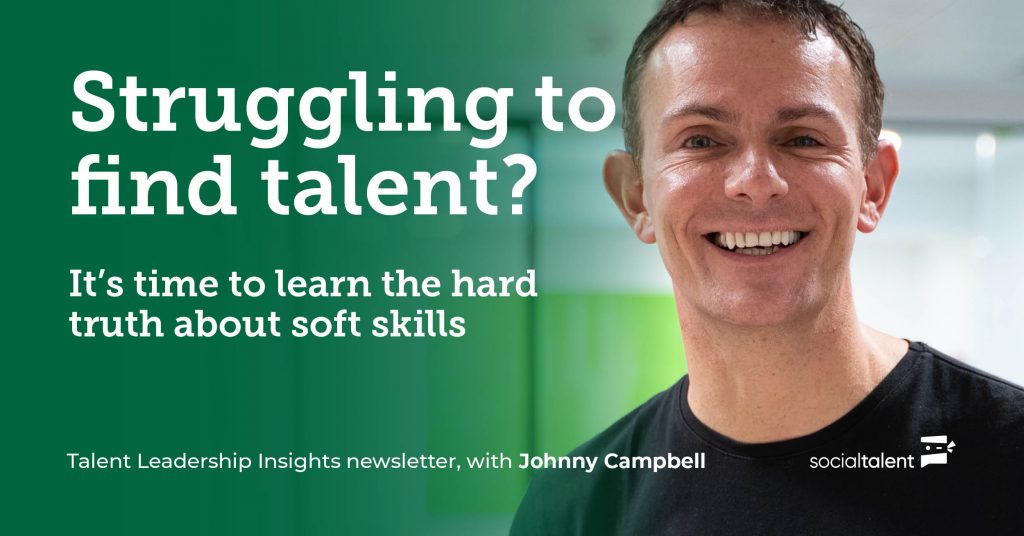Struggling to find talent? It’s time to learn the hard truth about soft skills
Soft skills are the currency of the workplace. We’ve been talking about this for years now, how we must hire on more than just years of experience or educational achievements. But as the best talent continues to be a scarce commodity and the air of economic uncertainty is only thickening, I think it’s time to start taking this approach seriously.

We know that soft skills – or, as I prefer to call them ‘workplace skills’ – are far more indicative of future job performance compared to hard skills. How an individual approaches work, builds relationships, communicates, and adapts fundamentally shapes everything they will do. And these characteristics aren’t role specific either, which makes them even more valuable.
When you put a bigger emphasis on workplace skills in the search for talent, it expands your pool immensely. Hard skills can be taught, developed, and perfected, but an innate ability to problem solve, or a tenacity for innovation – these are the skills that will bolster teams and drive success. Ten years of experience counts for nothing if the person hired creates toxic work environments that may increase attrition or has zero desire to upskill and learn.
Workplace skills aren’t just a gut feeling either. They’re tangible attributes that can be sourced and identified in candidates. It just takes a bit of a mindset shift to find them.
What skills should you be on the lookout for?
According to McKinsey, the top 3 most in-demand soft skills are:
- Problem solving, critical thinking, creativity
- Ability to deal with complexity and ambiguity
- Communication
And given its increasing importance in the modern workplace, I would also include leadership skills in that bracket. As Gallup’s book, It’s the Manager, says:
“For every 10 supervisors you’ve had throughout your career, you’d probably want to work for only two or three of them again. And that’s if you’re lucky.”
We know what it’s like to report into a manager who is naturally inclined to inspire and motivate people. It’s a completely different feeling. There’s little frustration, you feel empowered, clarity abounds. And the same rings true when the other core workplace skills McKinsey mentions are present too.
Being able to communicate clearly or look at a problem from different angles and suggest solutions – these are the things that inspire confidence and propel teams forward. Creativity sparks innovation. And tackling complexity with a cool head and rationality can save hours of toil. Simply put – soft skills are essential in every workplace.
How do you identify these workplace skills?
There are the tried and tested methods like behavioral interview questions that assess past actions to predict future ones. These could be scenario based, such as seeing how the candidate would share difficult feedback with a direct report, or how they explain new topics to coworkers who are unfamiliar to give an indication of their communication style. Personality tests can also render some useful data on how individuals operate. But is there a more authentic way?
While listening to an episode of Adam Grant’s WorkLife podcast recently about getting disabled talent into the workforce, I was struck by an interview process his guest, Gil Winch, had developed to encourage this.
Classic interviews have always been a barrier for people with disabilities. They aren’t designed to let people who haven’t had a traditional career path flourish. So Gil changed this. He ripped up the playbook and instead created interviews that would enable people to show their best selves.
Check out the full podcast here:
SocialTalent’s Interview Training for Recruiters will enable your teams to make the best hiring decisions. Get in-touch with us today to learn more.
The interview wouldn’t be a place of fear or rigid bureaucracy, they were opportunities to allow candidates to shine. Questions were adapted to real-life situations, rather than specific workplace ones. People would get to talk about what they were passionate about, and demonstrate skill through exercises that aren’t designed to make prospects trip up.
It’s all about screening in, rather than screening out. An interview conducted in this light gives the employer a chance to see the transferable, core skills a disabled person can bring to an organization and be successful. And it made me think… shouldn’t all interviews be like this?
While of course there does need to be some element of structure and guidelines for identifying the employees most suited to roles, surely there should also be space to get some genuine, unfiltered insight into the soft skills a candidate could possess?
Final thoughts
Finding talent is one of the toughest things an organization must do at the moment. There is an enormous need to expand the scope of hiring beyond traditional methods and tap these unjustifiably undervalued skills. Candidates with incredible problem-solving abilities should be as desirable as any university degree, we just need to reorient our thinking.
